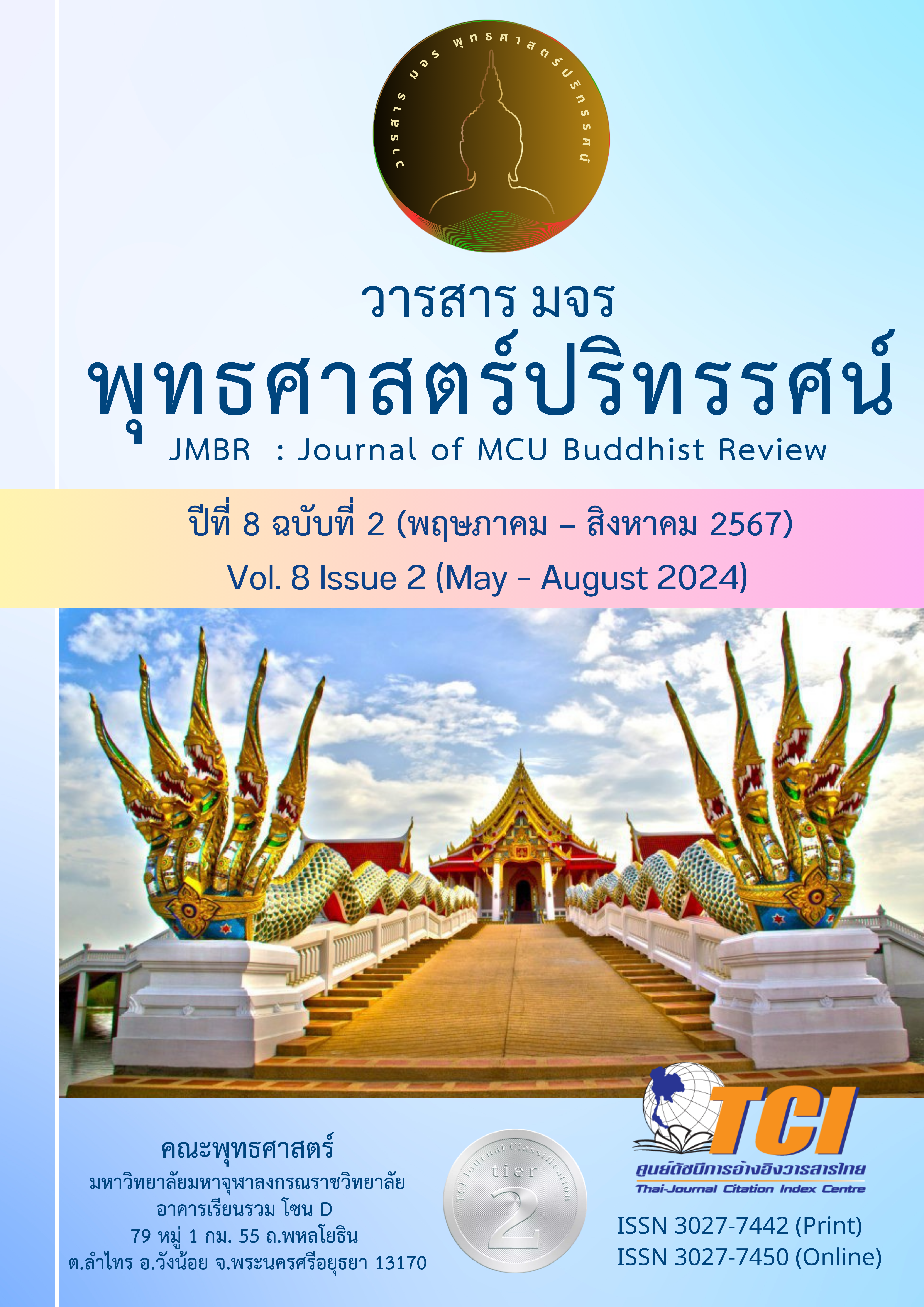ศึกษาพุทธวิธีการเผยแผ่หลักคำสอนแก่คนวรรณะต่ำในพระไตรปิฎก
Main Article Content
บทคัดย่อ
บทความวิจัยนี้มีวัตถุประสงค์ 1) เพื่อศึกษาพุทธวิธีเผยแผ่หลักคำสอนในพระไตรปิฎก 2) เพื่อศึกษาพุทธวิธีเผยแผ่หลักคำสอนแก่คนวรรณะต่ำในพระไตรปิฎก 3) เพื่อศึกษาวิเคราะห์ บทบาท ผลกระทบและแนวทางการประยุกต์ใช้ในสังคมร่วมสมัย เป็นการวิจัยเชิงคุณภาพโดยการศึกษาข้อมูลจากคัมภีร์พระไตรปิฎก อรรถกถา ฎีกา อนุฎีกา และคัมภีร์ร่วมสมัยอื่นๆ ที่เกี่ยวข้องและสัมภาษณ์แบบไม่มีโครงสร้างจำนวน 10 รูป/คน แล้วนำมาเรียบเรียงบรรยายเป็นเชิงพรรณนาเสนอผู้เชี่ยวชาญเพื่อตรวจสอบและแก้ไขตามคำแนะนำโดยใช้กระบวนการศึกษาวิเคราะห์นำไปสู่การ บูรณาการและสร้างองค์ความรู้ใหม่
ผลวิจัยพบว่า 1) พุทธวิธีเผยแผ่หลักคำสอนในพระไตรปิฎกครอบคลุมคำสอนของพระพุทธเจ้าว่าด้วยกฏเกณฑ์ หลักธรรมและการวิเคราะห์ทางปรัชญา ปรากฏวิธีการเผยแผ่หลากหลายแง่มุมที่สะท้อนถึงบทบาทในการสอนของพระองค์ มีสาระสำคัญ 4 ประการ (1) สันทัสสนา คือ การอธิบายเนื้อหาธรรมะให้ชัดเจน ตรงไปตรงมา เข้าใจง่าย (2) สมาทปนา คือ การชักจูงให้ผู้ฟังเห็นจริง เชื่อในสิ่งที่ได้ฟังและอยากนำไปปฏิบัติ (3) สมุตเตชนา กระตุ้นให้ผู้ฟังเกิดความกล้าหาญ มั่นใจ มีกำลังใจที่จะนำธรรมะไปปฏิบัติ (4) สัมปหังสนา สอนธรรมด้วยวิธีที่สนุกสนาน น่าสนใจ ทำให้ผู้ฟังรู้สึกเบิกบาน ร่าเริง 2) พุทธวิธีเผยแผ่หลักคำสอนแก่คนวรรณะต่ำในพระไตรปิฎกปรากฎการเผยแผ่คำสอนของพระองค์ไปยังวรรณะต่ำได้อย่างมีประสิทธิภาพโดยเฉพาะการยอมรับคนวรรณะต่ำเข้าสู่คณะสงฆ์เป็นการนำเสนอเส้นทางสู่การหลุดพ้นทางจิตวิญญาณที่ก้าวข้ามข้อจำกัดของระบบวรรณะ 3) วิเคราะห์ บทบาท ผลกระทบและแนวทางการประยุกต์ใช้ในสังคมร่วมสมัย เป็นการวิเคราะห์วิธีการเผยแผ่คำสอนสู่คนวรรณะต่ำคือการศึกษาพระไตรปิฎกภาษาบาลีอย่างลึกซึ้งซึ่งเป็นคัมภีร์ที่เชื่อถือได้ของพระพุทธศาสนาเถรวาทโดยการสังเคราะห์คำสอนและมีความหมายโดยนัยที่เผยแผ่เข้าสู่วรรณะต่ำมีหลักการสำคัญว่าด้วยบริบทและภาพรวมของพระไตรปิฎกบ่งชี้ถึงทัศนคติชาวพุทธต่อระบบวรรณะโดยสะท้อนถึงบทบาทและการประยุกต์ใช้ในสังคมร่วมสมัย
Article Details

อนุญาตภายใต้เงื่อนไข Creative Commons Attribution-NonCommercial-NoDerivatives 4.0 International License.
- บทความที่ได้รับการตีพิมพ์เป็นลิขสิทธิ์ของวารสาร มจร พุทธศาสตร์ปริทรรศน์
- ข้อความใดๆ ที่ปรากฎในบทความที่ได้รับการตีพิมพ์ในวารสาร ถือเป็นความรับผิดชอบของผู้เขียนบทความ และข้อคิดเห็นนั้นไม่ถือว่าเป็นทัศนะและความรับผิดชอบของกองบรรณาธิการวารสาร มจร พุทธศาสตร์ปริทรรศน์
เอกสารอ้างอิง
เดชา นามวงษา (คุณสมฺปนฺโน) และคณะ. (2022). การสอนตามแนวพระพุทธศาสนาเพื่อพัฒนาเยาวชนไทยในศตวรรษที่ 21. วารสาร มจร อุบล ปริทรรศน์. 7(3), 963-976.
บุญทอง พระพิทักษ์. (2023). การสอนตามพุทธวิธีเพื่อส่งเสริมความเป็นพลเมืองดีของนิสิต. วารสารสังคมศึกษาศาสนา และวัฒนธรรม. 4(1), 95-103.
พรพิมล จอโภชาอุดม, และคณะ. (2022). การวิเคราะห์กลยุทธ์การเผยแผ่พระพุทธศาสนาของพระพุทธเจ้าในพระไตรปิฎก. วารสารมจรพุทธศาสตร์ปริทรรศน์. 6(3), 115-132.
พระครูสถิตธรรมาลังการ (จำเนียน สุชาโต). (2024). การปฏิบัติวิปัสสนาภาวนาตามหลักสติปัฏฐาน 4 เพื่อการพ้นทุกข์. วารสาร มจร สุพรรณบุรีปริทรรศน์. 3(1), 57-70.
พระครูประสิทธิ์ภาวนาวิสุทธิ์. (2017). อุบายวิธีของพระพุทธเจ้าในการแสดงธรรมตามจริต 6 (พรชัย สุกธมฺโม/ประสิทธิ์สุขสันต์). วารสารพุทธศาสน์ศึกษาจุฬาลงกรณ์มหาวิทยาลัย. 24(3), 29-44.
พระมหากิตติธัช สิริปุญฺโญ. (2019). กลวิธีการสอนของพระพุทธเจ้าเชิงภาษาภาพพจน์ในพระสุตตันตปิฎก. วารสารบัณฑิตศึกษาปริทรรศน์. 15(เพิ่มเติม), 191-202.
พระธรรมปิฎก (ป.อ.ปยุตฺโต). (2003). พจนานุกรมพุทธศาสน์ ฉบับประมวลศัพท์. พิมพ์ครั้งที่ 10. กรุงเทพฯ: บริษัท เอส. อาร์. พริ้นติ้ง แมส โปรดักส์ จำกัด.
พระศรีพัชโรดม (ลักษณะ กิตฺติญาโณ) และ ชยุต ภวภานันท์กุล. (2560). รูปแบบการเผยแผ่พระพุทธศาสนาของพระสงฆ์ในสังคมไทย. วารสารบัณฑิตศึกษาปริทรรศน์. 13(2), 335-346.
มหาจุฬาลงกรณราชวิทยาลัย. (2539). พระไตรปิฎกภาษาไทย ฉบับมหาจุฬาลงกรณราชวิทยาลัย. กรุงเทพฯ: มหาจุฬาลงกรณราชวิทยาลัย.
มหาจุฬาลงกรณราชวิทยาลัย. (2539). พระไตรปิฎกออนไลน์ ฉบับมหาจุฬาลงกรณราชวิทยาลัย. สืบค้น 20 พฤศจิกายน 2566 จาก https://tripitaka-online.blogspot.com/2016/09/tpd-main.html
เมธี เชษฐ์วิสุต. (2019). สื่อสังคมออนไลน์กับการเผยแผ่พระพุทธศาสนา. วารสารพุทธศาสตร์ศึกษา. 10(2), 1-11.
สุชีพ ปุญญานุภาพ. (2504). อริยสัจจ์คืออะไร?. กรุงเทพฯ: มหามกุฏราชวิทยาลัย.
สุชีพ ปุญญานุภาพ. (2548). พระไตรปิฎกฉบับประชาชน ตอนว่าด้วยพระสูตร. กรุงเทพฯ: กรมการศาสนา.
หลินภู มนตรี, เจือจินดา สมิทธิ์, และ โพธิผลิ วรรณนภา. (2023). ความสอดคล้องของพฤติกรรมมนุษย์ตามแนวทฤษฎีผู้นำสัตว์ 4 ทิศ กับจริต 6 ในทางพระพุทธศาสนา. วารสารพุทธจิตวิทยา. 8(1), 97-109.
Collett, A. (2006). Buddhism and gender: Reframing and refocusing the debate. Journal of Feminist Studies in Religion. 22(2), 55-84.
Guruge, A. W. (2003). How the Buddha taught. Hsi Lai Journal of Humanistic Buddhism. 4(1), 23-53.
Phramaha Kittithat Siripuñño Nachai. (2019). The Buddha’s teaching strategies on figurative languages in Dīgha NikĀya. Journal of Graduate Studies Reviea. 15(Supplemental Issues), 191-202.
Thanyathanakul,S. Saisaeng, P. & Phra Maha Saiyan Phemasilo. (2019). Guidance in Buddhism: Analysis of the Sutta Pitaka. Nisit Wang Journal. 21(1), 1-12.
Yesapogu, V. (2016). The nature of Hinduism, Buddhism and Christianity on caste system: In view of Ambedkar’s philosophy – A critical elucidation. International Journal of Research. 3(3), 1-6.


